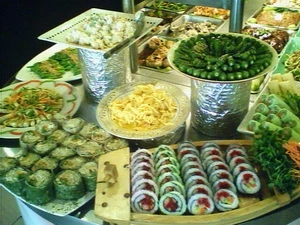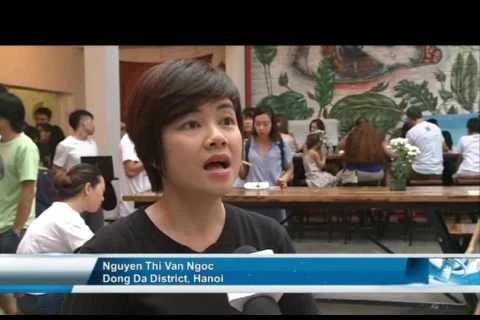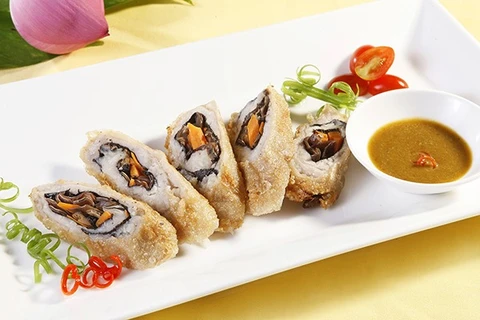Hanoi (VNA/VNS) - Vegetarian food, mostly vegan, has become increasingly popular in Vietnam over the last few years. All major cities, including the capital, have many restaurants that serve vegan food, and their number is increasing.
There are many reasons that more and more people are turning vegan, even in Vietnam, where daily meals, breakfast, lunch and dinner, invariably contain meat. In fact, all iconic dishes in the national cuisine, whether it is Pho or Bun or Banh my, are meat-based.
For many Vietnamese, a vegan diet is traditionally confined to two sacred Buddhist days a month, an observance of compassion for all sentient beings.
There are many reasons that more and more people are turning vegan, even in Vietnam, where daily meals, breakfast, lunch and dinner, invariably contain meat. In fact, all iconic dishes in the national cuisine, whether it is Pho or Bun or Banh my, are meat-based.
For many Vietnamese, a vegan diet is traditionally confined to two sacred Buddhist days a month, an observance of compassion for all sentient beings.
But increasing numbers of people are also turning to a plant-based diet for health reasons, and are strengthened in their resolve by environmental considerations.
With its abundance of delicious vegetables, fruits and roots, Vietnam has all the conditions to cater to vegans.
Vegans can find in Vietnam a variety of vegetarian dishes. However, the most common vegan dishes are made of soybeans. Apart from tofu, steamed and fried, soybeans lend themselves to soya paste, fermented tofu, veggie Vietnamese ham and a wide variety of other dips and dishes.
Since soybeans are nutritious, rich in protein and calcium, and non-fattening, they are a good replacement for animal meat. They are also said to be useful in treating several illnesses, including heart disease and cancer.
Vegans can also find in Vietnam many dishes that look like they’re made with real meat. For example, chicken legs are made of citronella stems with a special tofu wrapping that even has the texture of meat. Barbecued pork chops, beef wrapped in la lot leaves, stewed chicken, steamed fish – the list goes on and on.
The faux meat dishes are consumed more in the South than in the North, says Pham Tuan Hai, a judge in the Masterchef Vietnam reality television show.
Veggie histories
Although vegetarian and vegan food has become more popular nationwide, the importance of vegetarian food differs from region to region.
Several decades ago, any mention of vegetarian food evoked Hue City in central Vietnam.
“The art of vegetarian food first appeared in the central provinces of Vietnam, and Hue was one of the first cities in the country where vegetarian meals appeared. Vegetarian meals are very important to the people of Hue,” says Hai.
Historically, vegetarian food first became popular during the reign of the Ly Dynasty in 11th century. However, it reached its zenith as a important part of royal cuisine during the long rule of the Nguyen Dynasty since early 19th century, when Hue emerged as a Buddhist centre.
“There were strict rules on picking the right ingredients, cooking and offering vegetarian food to royalty during the reign of the Nguyen Dynasty,” says vegetarian food expert Ho Dac Thieu Anh of Hue.
She explains that the team of chefs serving royalty had to offer the King the finest food as part of a royal ritual, a prayer for peace and prosperity in the kingdom. During this special ritual, the King kept himself clean and his mind tranquil. The cooks also had to be clean and extremely selective of the food they chose to make the offerings. Above all, the vegetarian feast had to be presented beautifully, with ornate decorations.
Since then, eating vegetarian food has become a tradition in Hue.
In all pagodas in Hue, every month, on the first and full moon days of the month, monks and nuns make vegetarian meals to feed the devotees.
Restaurants that normally sell non-vegetarian food used to close on these two days or change their menu to serve vegetarian food.
Most Hue residents turn vegetarian during the first and full moon days of the month and on other festive days. The first day of the New Lunar Year, for instance, is a day of vegetarian meals for many families in the city.
“I started to eat vegetarian food when I was very small, with other members of my family, so this has become a habit. Twice a month, mother always cooked vegetarian dishes from vegetables, or tofu and told us not to eat onion and garlic.
Now, I want to stay healthy. And I also want to cleanse my body,” says Nguyen Ngoc Lan, explaining her vegetarianism.
Not as important
According to Hai, vegetarian food does not carry the same importance as in Hue in terms of the royal history and Buddhist leanings, but its popularity has been increasing nevertheless.
Some restaurants in HCM City have begun to close on first and full moon days, but these are very few in number. The number of street restaurants serving vegetarian food, however, has exploded. In fact, it is in HCM City that the whole range of vegetarian eateries can be found with ease, from the most humble street side stall to the most luxurious, up market places.
Also particular to HCM City are whole stretches of a street or alley that exclusively serve vegetarian food. The Chay Xom Gia, for instance, is located on a 100m long alley on Hong Bang Street in District 11. Sixteen stalls sell vegetarian food at cheap prices, and these are frequented by low-income workers.
The late entrant
In comparison to Hue and HCM City, vegetarian food has been late in coming to Hanoi, but even here, the difference from a few years ago is apparent. Like other provinces in the north, vegetarian food was mostly served in pagodas, but there are now several dozen places in the capital city that serve just vegan food. These places, like in other cities, often carry photographs and/or quotes from world-famous people, including scientists like Albert Einstein and Hollywood celebrities like Justin Timberlake and Kate Winslet, to promote a vegetarian or vegan diet.
As Hai observes, contrary to HCM City and Hue, people in Hanoi cannot find vegetarian food in street-side stalls. A street-side stall that sells only vegetarian or vegan food is a rarity here, but that looks set to change soon.—VNA
With its abundance of delicious vegetables, fruits and roots, Vietnam has all the conditions to cater to vegans.
Vegans can find in Vietnam a variety of vegetarian dishes. However, the most common vegan dishes are made of soybeans. Apart from tofu, steamed and fried, soybeans lend themselves to soya paste, fermented tofu, veggie Vietnamese ham and a wide variety of other dips and dishes.
Since soybeans are nutritious, rich in protein and calcium, and non-fattening, they are a good replacement for animal meat. They are also said to be useful in treating several illnesses, including heart disease and cancer.
Vegans can also find in Vietnam many dishes that look like they’re made with real meat. For example, chicken legs are made of citronella stems with a special tofu wrapping that even has the texture of meat. Barbecued pork chops, beef wrapped in la lot leaves, stewed chicken, steamed fish – the list goes on and on.
The faux meat dishes are consumed more in the South than in the North, says Pham Tuan Hai, a judge in the Masterchef Vietnam reality television show.
Veggie histories
Although vegetarian and vegan food has become more popular nationwide, the importance of vegetarian food differs from region to region.
Several decades ago, any mention of vegetarian food evoked Hue City in central Vietnam.
“The art of vegetarian food first appeared in the central provinces of Vietnam, and Hue was one of the first cities in the country where vegetarian meals appeared. Vegetarian meals are very important to the people of Hue,” says Hai.
Historically, vegetarian food first became popular during the reign of the Ly Dynasty in 11th century. However, it reached its zenith as a important part of royal cuisine during the long rule of the Nguyen Dynasty since early 19th century, when Hue emerged as a Buddhist centre.
“There were strict rules on picking the right ingredients, cooking and offering vegetarian food to royalty during the reign of the Nguyen Dynasty,” says vegetarian food expert Ho Dac Thieu Anh of Hue.
She explains that the team of chefs serving royalty had to offer the King the finest food as part of a royal ritual, a prayer for peace and prosperity in the kingdom. During this special ritual, the King kept himself clean and his mind tranquil. The cooks also had to be clean and extremely selective of the food they chose to make the offerings. Above all, the vegetarian feast had to be presented beautifully, with ornate decorations.
Since then, eating vegetarian food has become a tradition in Hue.
In all pagodas in Hue, every month, on the first and full moon days of the month, monks and nuns make vegetarian meals to feed the devotees.
Restaurants that normally sell non-vegetarian food used to close on these two days or change their menu to serve vegetarian food.
Most Hue residents turn vegetarian during the first and full moon days of the month and on other festive days. The first day of the New Lunar Year, for instance, is a day of vegetarian meals for many families in the city.
“I started to eat vegetarian food when I was very small, with other members of my family, so this has become a habit. Twice a month, mother always cooked vegetarian dishes from vegetables, or tofu and told us not to eat onion and garlic.
Now, I want to stay healthy. And I also want to cleanse my body,” says Nguyen Ngoc Lan, explaining her vegetarianism.
Not as important
According to Hai, vegetarian food does not carry the same importance as in Hue in terms of the royal history and Buddhist leanings, but its popularity has been increasing nevertheless.
Some restaurants in HCM City have begun to close on first and full moon days, but these are very few in number. The number of street restaurants serving vegetarian food, however, has exploded. In fact, it is in HCM City that the whole range of vegetarian eateries can be found with ease, from the most humble street side stall to the most luxurious, up market places.
Also particular to HCM City are whole stretches of a street or alley that exclusively serve vegetarian food. The Chay Xom Gia, for instance, is located on a 100m long alley on Hong Bang Street in District 11. Sixteen stalls sell vegetarian food at cheap prices, and these are frequented by low-income workers.
The late entrant
In comparison to Hue and HCM City, vegetarian food has been late in coming to Hanoi, but even here, the difference from a few years ago is apparent. Like other provinces in the north, vegetarian food was mostly served in pagodas, but there are now several dozen places in the capital city that serve just vegan food. These places, like in other cities, often carry photographs and/or quotes from world-famous people, including scientists like Albert Einstein and Hollywood celebrities like Justin Timberlake and Kate Winslet, to promote a vegetarian or vegan diet.
As Hai observes, contrary to HCM City and Hue, people in Hanoi cannot find vegetarian food in street-side stalls. A street-side stall that sells only vegetarian or vegan food is a rarity here, but that looks set to change soon.—VNA
VNA























